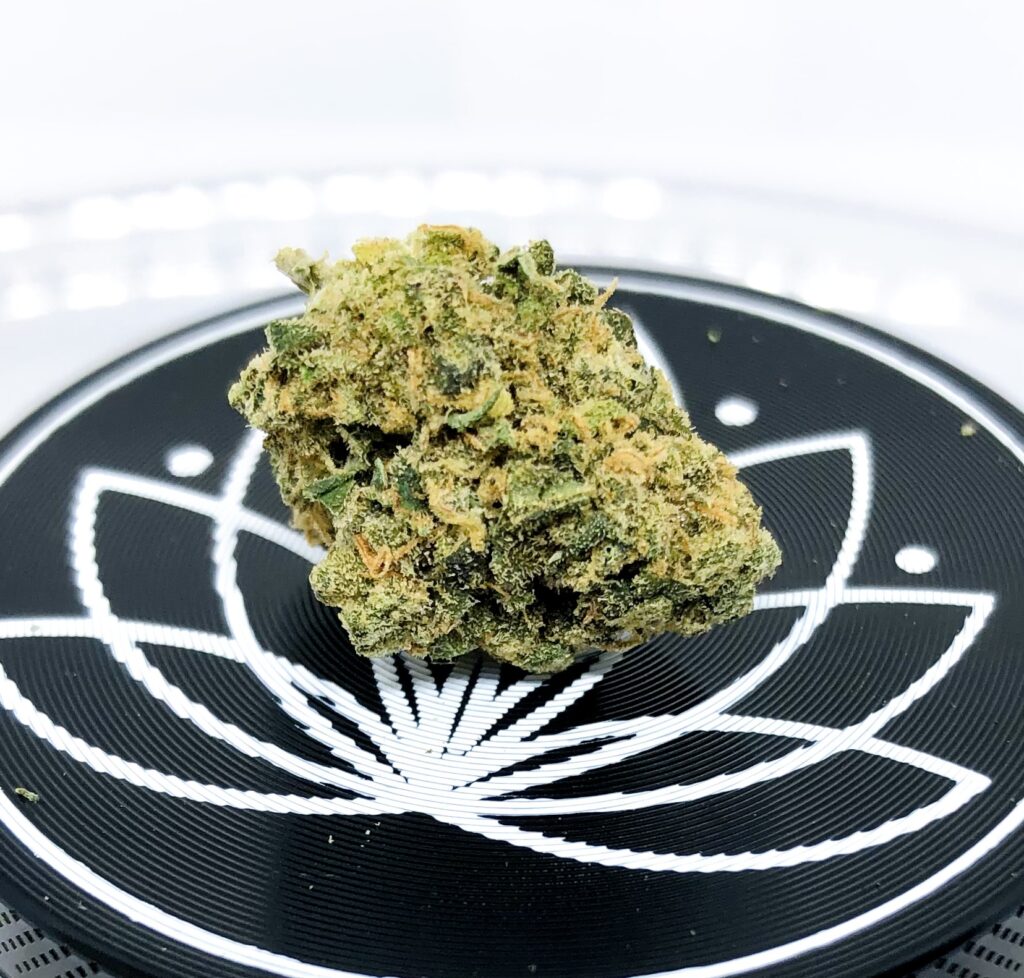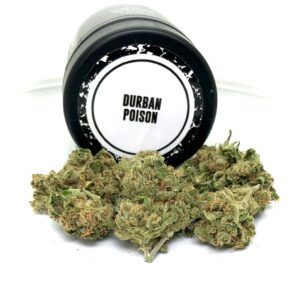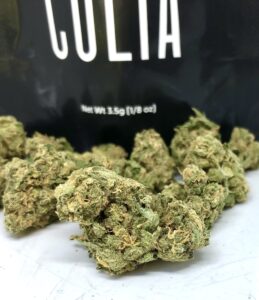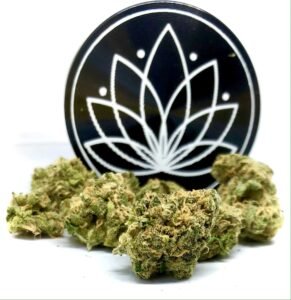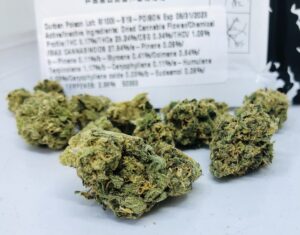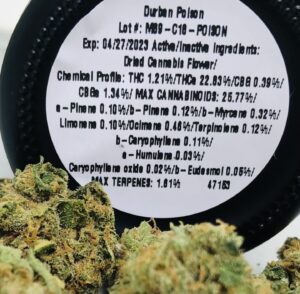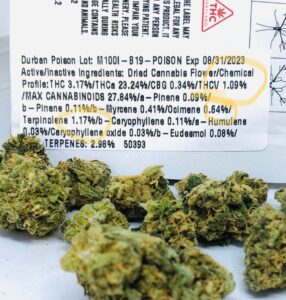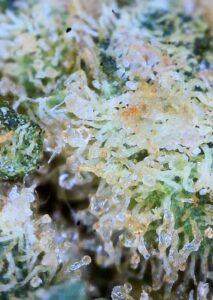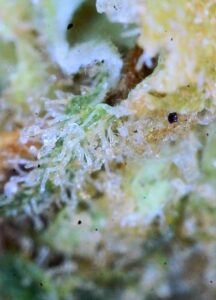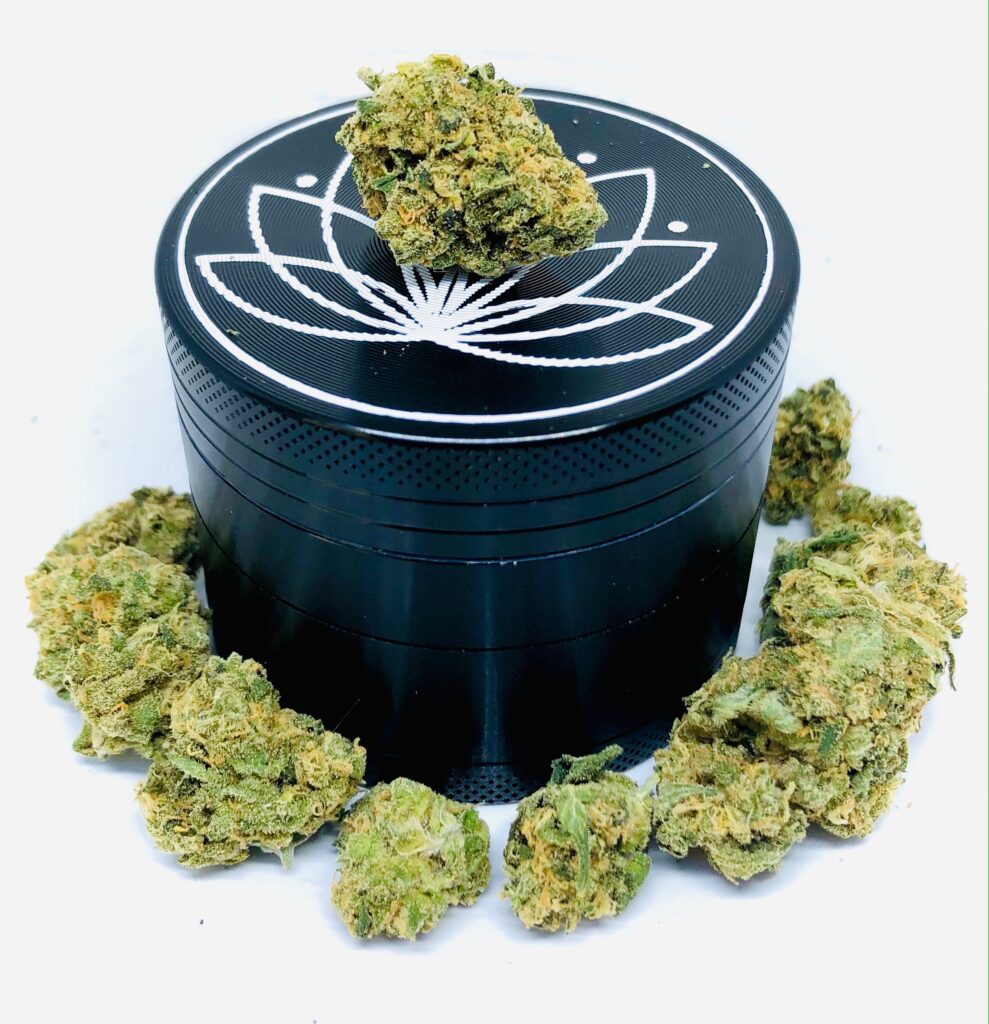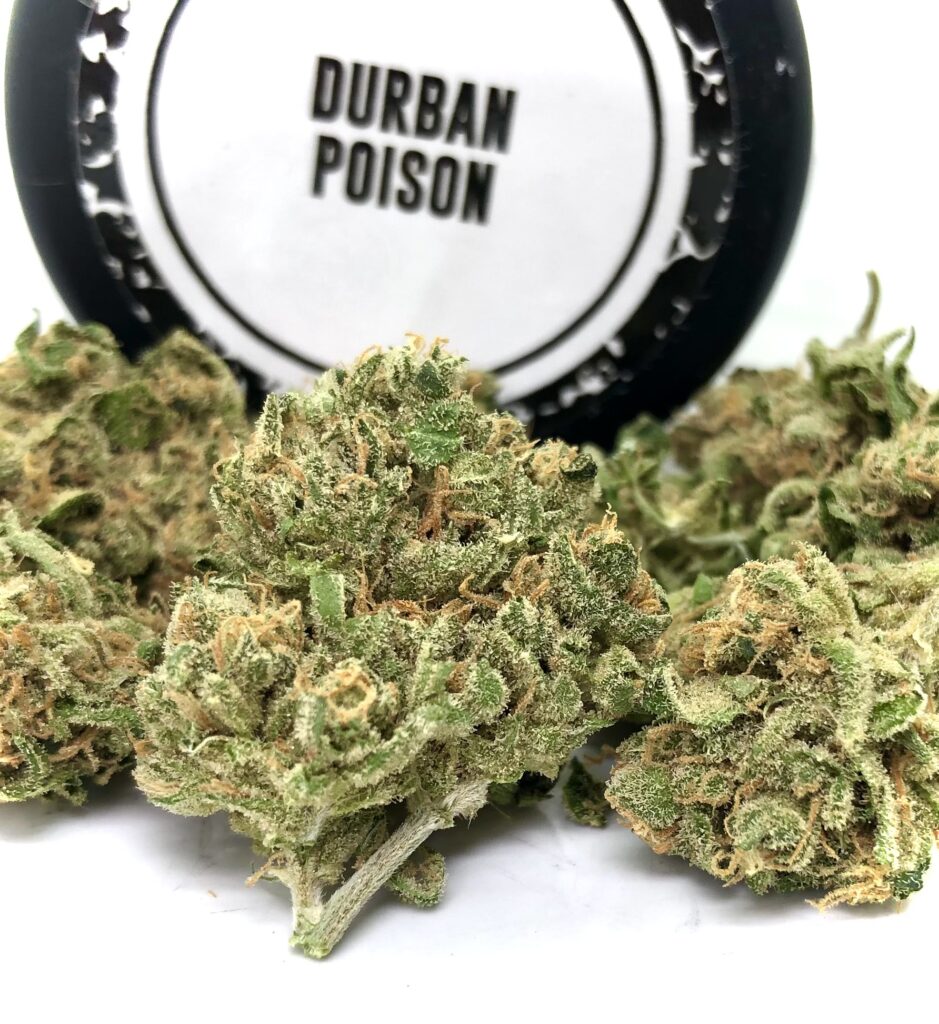
DURBAN POISON
MEDIUM: Flower
POTENCY: Med-High
BATCH 1
THCa 18.10%fff/ THC 0.30%
High levels of:
THCV 1.09%
Terpinolene 1.17%
Ocimene 0.64%
BATCH 2
More potential to be sedative due to higher levels of terpinolene
THCa 23.24% / THC 3.17% / TOTAL Terpene content 2.98%
TOTAL Cannabinoid content 27.84%*
TOTAL Terpene content. 2.98%
Quite a disparity in potency to say the least.
CULTIVATOR: Culta
CLASS: Durban Poison’s morphology is that of a structurally Sativa dominant or narrow leafed strain typical of tropical varieties and with a cerebrally-dominant / physically subordinate psycho-physical effect profile
Cerebral > Physical
PURCHASED: Nirvana Center, Catonsville, MD
LINEAGE: Original South African (Equatorial) Landrace strain
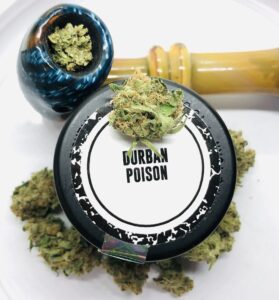
EFFECTS (MIND + BODY):
Culta’s rendition of Durban Poison is potent the magnitude of which can be felt even at 23% THC in micro doses.
The sheer incline of its initial ramp up of cerebral euphoria is steep, its peak quite daunting to some, and its descent substantially sedative depending on dosage of course. This increased sedative potential is something not normally associated with Durban Poison. More on that later.
Durban Poison is mostly known for its ability to inspire the mind and then propel the body into action. Culta’s version does not chart the same course except when ingested in micro and medi doses.
Culta’s version carries a bit more of a lazy, hazy, sedative high due, in part, to the high level of terpinolene in BATCH 2. I’m not sure what accounts for the disparity between terpinolene levels in BATCH 1 and 2.
In higher doses Culta’s Durban takes on a definite narcotic quality which can cause some dizziness in higher doses. Batch 1 contained moderate percentages of THCV and terpenoline both typically found in Durban Poison. Indeed, Batch 1 was closer to what most who have experienced Durban Poison in the past, would expect: a high minded focus driven cerebral high that does more to motivate than sedate.
So I would say for those who want to experience the rush of Durban Poison through Culta’s efforts: Look for batches with low to medium levels of terpinolene and ingest micro doses at first.
She’s a Creeper
Remember that Durban Poison is thought of as a “creeper” strain having a delayed onset of effects. This can be overwhelming for some who may over ingest in the beginning without waiting for the effects to develop and consequently being hit all at once with what many describe as a very psychoactive high.
I believe this “creeping” effect to be somewhat common in strains with equatorial genetics for whatever reason. So take it slow.
If you don’t immediately inhale and instead let the smoke or vapor linger a bit in the mouth and then exhale partially through the nose, you may taste some of flavors that have come to characterize Durban Poison and its many descendants, such as licorice and just a hint of pine, but the aroma of a strong skunky mint dominates the experience.
One of Durban Poison’s greatest gifts; to be able to inspire the mind and then the body, to action. Its ability to both inspire and motivate allow Durban Poison to stay enthroned as the mother of all cerebrally effect dominant worker strains.
So, for the most part, Culta’s rendition delivers, but not exactly what you expect from the pride of Durban.
And compared to GR version, Culta’s Durban Poison has a thicker layer of physical euphoria or let’s say just a bit more weight in the physical effects department. I’d say higher levels of terpinolene in BATCH 2 can be thanked for the extra weight so to speak.
Also, Durban Poison usually suppresses the appetite because of its THCV levels. Batch 1 contained literally zero THCV whereas BATCH 2 had a whopping 1.09%, the highest I’ve ever seen.
I’d Say Culta’s Durban Poison is about a 3 out of 4. It may be a grand slam with an adjusted terpene profile with a decrease in terpenoline.
And even though in the long run this makes it more functional for sleep, it runs counter to what one would expect from Durban Poison in a classic sense.
MIND
- Immediate uplifting cerebral euphoria
- Improved /heightened awareness
- Improves focus and attention to detail
- Energizing and mobilizing
- Amplifies/ inspires enhanced creativity / creative thinking in creative individuals
- Potential for “brain-race” in some users in the initial stages of the high. But as the creeping high develops into a more actionable state of physical motivation this potential for mental stress or anxiety is diminished to a more functional feeling of well being.
BODY
- Potential for dizziness at higher doses depending on terpenes and the tolerance of the user light to medium cranial and facial pressure
- Dry eyes at higher doses
- Dry mouth at medium to high doses
- Appetite suppressant (Durban Poison is generally considered to be an appetite suppressant but this is due to it sometimes containing traces of THCV known for its ability to suppress appetite.
BATCH 1 of Culta’s Durban contained no THCV. Culta’s Durban actually made me quite hungry but not as hungry as a strain like Scooby Snacks may have; just more for Durban Poison which normally staves off appetite.
The percentage of humulene, a terpene thought to reduce hunger, was also quite low and wouldn’t seem to affect appetite one way or the other. - Potential for dizziness and disorientation with such high levels of terpinolene In the 2nd and most recent batch. High dosages can definitely lead to a not so pleasant dizzying effect. This can only lead to sedation as your eyelids fight to stay open only to be greeted with a shifting and seemingly unstable landscape better appreciated from a horizontal position.
BATCH 2 had a more physically sedating effect with notably higher levels of terpinolene
Culta’s version carries a bit more of a lazy, hazy, sedative high than I’ve come to expect with Durban Poison.
APPEARANCE, AROMA + TASTE
APPEARANCE:
Although BATCH 1 and BATCH 2 did have differences, their optics were very similar.
Depending on the pheno, Durban Poison is a distinct and visually appealing flower. Culta’s version is also attractive. Trichome coverage is notable but not extreme and the pistils/stigma/ “hairs” are well developed, lengthy, and robust in shape casting a pink or peach-orange hue.
Culta’s Durban Poison is quite attractive. At first glance nothing stands out per se, except the fact that the dram that they insist on using is almost filled to the rim giving one the impression they’ve gotten their monies worth for sure.
The buds have a natural look to them and are just about the perfect density for thoroughly, but recently, cured cannabis.
BATCH 2 seemed to be more illustrative of a hand trimmed eighth of flower from Culta; it was a little neater in some respects. This was amplified by the 2nd batch’s denser buds.
Receiving noticibly hand-trimmed flower is somewhat refreshing in a world where some feel the need to that advertise their machine trimmed herb that looks like it was shorn by Rosie-the-Robot (I suppose to reassure patients that no other human has handled their flower?…dream on).
In comparison, Culta’s Durban looked wonderfully wild.
I did get the impression that a someone took great care during the final trim, which to me is worth paying for.
HERE ARE SOME SIMILARITIES AND DIFFERENCES BETWEEN THE 1ST AND 2ND 1/8TH OF CULTA’S DURBAN POISON (BATCH 1 AND 2)
BATCH 1
- comprised of several smaller buds
- The typical spade shaped buds of Durban Poison are in full effect here in varying sizes. There isn’t much variance amongst the leaf/bud material but the predominant green is very robust and seems to be superbly cured.
- had more buds of decent size closely followed by several medium size clunkers.
- seemed to have been procured or cured in a rushed manner as there was still some grassy almost “hay” notes still present.
BATCH 2
- was comprised of several medium sized buds; a little more dense than the 1st
- the density was on point in fact just about perfect offering the slightest give after being pressed.
- had more preserved outer guard leaves still attached with variegated leaf material which housed droves of tiny semi-cloudy trichomes.
BATCH 2 smelled much better. It is known and documented that terpenes will further develop after harvest and that some terpenes are formed during the cure and not present at harvest. So, the cure plays a huge part in the final nose and flavor of any strain.
I feel that BATCH 2 had a better cure and that extra curing time and effort even yielded higher levels of ocimene and terpinolene. The resin content is high and my hands retained a sticky residue after completing squeeze test to determine the aforementioned density of the buds.
The rust red stigma/pistils/“hairs” are quite typical of Durban Poison and wonderfully displayed throughout with a sort of peach color at times.
AROMA:
- Beyond morphology and on to aroma: My only experience with Durban Poison in Maryland, before this eighth from Culta, has been with Grassroots (REVIEW COMING SOON). The telltale aroma of licorice or anise has been consistent with Grassroots even after being acquired by Curaleaf.
The licorice scent typically emitted cured Durban Poison is indeed onboard with Culta’s version as well but below deck and detected more on the tongue during the exhale more than in the outward bouquet of the flower upon opening the dram.
But all in all both Batch 1 and 2 were relatively recently harvested and for all intents and purposes, fresh flower – the intense mint scent is most likely due to a higher than average ocimene levels in both BATCH 1 and 2 (0.46% and 0.64% respectively) - The mint is overbearing but a deeper olfactory inspection reveals that classic Durban Poison licorice /anise aroma that you expect when encountering this landrace legend. But, I would say with Culta’s Durban (both BATCH 1 and 2) the telltale anise/licorice that has come to characterize Durban Poison (typical, in my opinion of the late 80’s-early 90’s Dead lot Durban Poison) is more obscured with Culta’s version and harder to discern beneath the overwhelming aroma of herbaceous mint. BATCH 2 had even more Ocimene and thus a mint-ier aroma all around.
- Mint / herbaceous mint aroma [STANDOUT]
- pine needles
- Sandalwood
- Herbaceous lemon
- licorice /anise – notes on exhale mostly; overshadowed by herbaceous mint (Very faint in BATCH 2)
The tell tale licorice /anise aroma of Durban Poison is present, but seems to be playing a supporting role to the outward herbaceous mint aroma.
TASTE:
- Herbal- licorice/ anise
- Some slight licorice/anise aroma that can be a characteristic of Durban Poison was a bit drowned out by the herbaceous mint aroma, most likely attributable to higher percentages of the terpene Ocimene (BATCH 1 & 2)
- Chem-slight artificial licorice like Black Jack gum flavor on exhale (BATCH 1)
PACKAGING:
I think its worth noting that batch 1 came in Culta’s typical top-shelf black glass dram.
But, Batch 2 came in Culta’s new money saving ziplock. It seems I may have accurately predicted this move to ziplock bags for the sake of economy, low overhead and lower prices at the dispensary. I predict that soon the other cultivators in Marlyand and elsewhere will follow with the same.
As ziplocks go Culta’s does a fairly decent job of keeping the trichomes from sticking to it and it is relatively easy to open.
POTENTIAL THERAPEUTIC AND/OR MEDICINAL APPLICATIONS:
For the most part, except in some individuals, Durban Poison’s normally robust levels of pinene are inconsequential and usually somewhat tamed by a presence of terpinolene. That being said, the extra, almost unprecedented levels of terpinolene in Culta’s Durban would be suited for individuals who want to experience the power of a cerebral strain like Durban without the worry of its normally hyperactive buzz precipitating anxiety
- ADD (Attention Deficit Disorder
- Nausea
- IED (intermittent Explosive Disorder)
- Depression or depressive thoughts
- Stress/Anxiety
- Appetite suppressant*
- Lack of Motivation or lethargy (except in higher doses which can provide its own sedentary prowess)
*Not recommended for patients attempting to stimulate appetite, jumpstart their metabolism, or counter anorexia
** have not experienced this personally yet)
OTHER APPLICATIONS:
- Creative endeavors
- Outdoor activities
- Most any activity, enjoyable or not, at any point in the day, will be enhanced and made more enjoyable by this strain.
- This strain is quick to mobilize the body to match the uplifting and motivating mental stimulation
* Higher doses (at least Culta’s version) may help facilitate sleep and hold great efficacy for those dealing with a lack of sleep and other sleep disorders, ADD and ADHD
A CLOSER LOOK INSIDE
The Terpo-Chemical profile of Culta’s Durban Poison BATCH 1 and BATCH 2 compared and contrasted
Of the 2.93% terpenes in this batch of Culta Durban Poison, Terpinolene and Ocimene are two of the most concentrated. BATCH 2 also contained an interesting cannabinoid that is not normally seen save for tropical or equatorial strains like Durban Poison, THCV.
THCv
The Cannabinoid THCV is not as well understood as others like CBD, which is still in the discovery stages for the most part. It is somewhat rare in cannabis and has been mostly documented to be found in higher concentrations in cannabis grown south of the equator.
The Port Of Durban is south of the equator so it makes sense that its landrace namesake, Durban Poison, is often associated with higher levels of the cannabinoid THCV.
BATCH 1 of Durban Poison had zero THCV and BATCH 2 had a lot, 1.09%, which is quite high for a rare cannabinoid usually found in strains that grow south of the equator.
As more is learned about THCV and its potential benefits, a finer appreciation of its presence within strains’ terpene profiles will undoubtedly be more meaningful to the larger conversation.
Terpinolene
Terpinolene is found in many trees like pine, apple, fir trees as well as sage, rosemary and lilac to name a few.
And although it is also found in cannabis it is considered to be a rare, especially in higher concentrations.
The higher levels of terpinolene in Culta’s Durban may overshadow the other terpenes’ effects much like the ocimene dominates the aroma.
There are some exceptions of course, and it can be quite often found in some strains such as Jack Herer, Orange Cookies, Modified Grapes, and Holy Roller (also grown by Culta).
While some cannabis terpenes, like limonene and even pinene may have more uplifting and energizing effects, terpinolene may impart a spacey or even sedative effect, especially in higher doses. For some it may precipitate feelings of physical relaxation and drowsiness in higher doses or, for others, elongate the initial cerebral uptick in focus.
Durban Poison is usually chosen for its more alerting and uplifting effects rather than facilitating sleep. However, Culta’s Durban, with its higher levels of terpinolene can indeed cause somnolence. And, in medium-high to high doses, it could be utilized to shed the stress of the day to a sedative end.
Modulating by the dose
Whether a strain’s effects can be more cerebral or sedative can many times be dependent on the level of ingestion and can be modulated as such. For instance, micro to medium or “medi” doses can harness the more spacey effects of terpinolene and help one achieve a state of tranquility; while higher doses may initiate more of a sedative effect for others.
In order to bypass the potential sedation, one may consider “micro” or “medi” (medium) dosing. This can amplify the more uplifting and focus enhancing side of a strain’s effects rather than the more sedative aspects.
Likewise, I believe that whether or not the combined effect of terpinolene and THC is physically sedating or spacey depends more on the dosage and each individual’s endo-cannabinoid system along with their level of tolerance rather than the percentage of any terpene or group of terpenes.
Terpinolene seems to be a terpene that can precipitate feelings of physical relaxation and some drowsiness or, for others, enhance the initial cerebral uptick in focus to last for longer periods of time.
So, a flower with this much terpinolene, like Culta’s Durban Poison, may offer more of a cerebrally uplifting and functional high when ingested in smaller doses and the more sedative effects will be felt in higher doses.
Personally speaking, micro to medium or “medi” doses seem to allow both my body and mind to harmoniously relax with a sensation of calm delight and elevated tranquility rather than render me sedate or even drowsy.
I think overdoing it or ingesting too much of this strain is what brings out the sedative properties or let’s playfully say the “Poison” in Durban Poison. A few over the line and what was uplifting and inspiring can be disorienting and dizzying.
NOTE: To date I don’t believe there has been a conclusive study regarding the effect of any one single terpene on the human body in conjunction with THC and other cannabinoids like THCV and terpenes like terpinolene. The data is still arriving or has not even begun in many cases. And who knows what the different combinations of common terpenes like limonene, terpinolene, and myrcene may have in any certain proportion or ratio. Will a flower with its top 3 terpenes being limonene, caryophyllene, and pinene have different effects than one with the same terpenes but in reverse order of concentration? Most likely yes, but does it matter that the ratio of these three is 1:1:1 or 4:1:1? I don’t think we have solid data for this yet and we may never have. However, hopefully as we learn more we will be able to better predict what different terpene concentrations and arrangements or groups may do to anyone’s mind or body.
Durban’s ability to physically motivate, mentally stimulate, and potentially stave off hunger, seems to make it a strain perfectly fit for people living in the sometimes harsh unforgiving landscapes of a country like Africa. It is in many ways, the perfect strain to energizing the body and mind to action, stave off hunger, and keep the mind alert.
Culta’s version carries through with most of these effects but with an added layer of potential sedation.
MACRO
The following macro photos show the clear to semi-clear trichomes of Durban Poison which somewhat predicts the high to be more cerebral. What’s really interesting with this pheno or batch of this pheno of Durban Poison is fairly sedative when ingesting medium to large doses in a session. This can be seen in the first photo where the trichomes have matured to have a more amber look as well as the trichome heads being somewhat cloudy.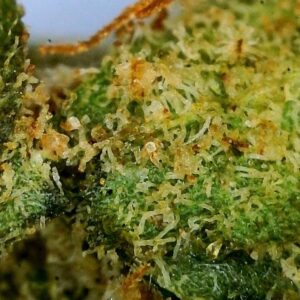
Culta’s Durban Poison has many of the same characteristics as say the Durban F1 strain from the Cookies Family, however it also packs quite a physically sedating component that can render one at the very least somnolent.
If Culta has procured this Durban from the F1 route we might never know. One clue that it may not be is the over-the-top level of terpinolene. But, at this point there are so many different versions and offshoots of Durban Poison that it is almost impossible to tell.
The next Macro image shows a more clear headed trichome landscape indicative of an early harvest before the trichomes have developed into an amber color and ultimately a more cerebral high.
There is usually a mix of these types, especially in hybrids, but cerebral strains tend to have more clear than amber. It begs the question:
If you let Durban Poison over ripen would it be more sedative? The answer to that would yes and I believe that may be what has happened with the high terpinolene levels. My theory is Culta let this crop develop in order to harness all they could from the terpenes. It is well known that some terpenes are present only during the cure and undetectable or non-existent when the plant was growing. The curing process itself can bring about changes to terpenes.
One concerning find when viewing Culta’s Durban Poison under a microscope was this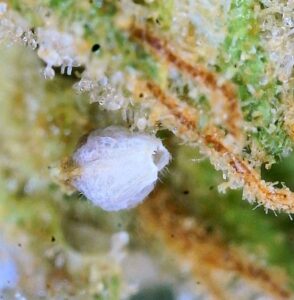
Im not quite sure what I’m looking at here but it seems to be an egg sack for a spider mite maybe(?). I suppose it could be some bio-remnant from a purposely introduced beneficial bacteria or organism but yikes. I thought maybe it was mold but the rest of the flower looked to be free of any contaminants. I see a lot of things that one may think strange when viewing flower this way. But, usually it is just a strange distortion of a once pristine landscape that has been cut down, harvested, cured, packaged, etc. basically beat up many times before it gets in your pipe or vape. Or, other times it’s strands of fiber from the trellis used by the cultivator. But, this is a new one on me and quite frankly it looks to be more animal than mineral or vegetable. The tiny black specks are scratches or debris caused by some damage that my lens recently suffered. The white web-like anomale is what’s really interesting. Take another look.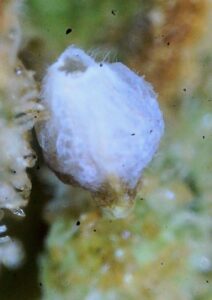
CONCLUSION:
Durban Poison is a South African Landrace strain known for its uplifting and energizing cerebral effects which can elevate mood, inspire creativity, and spurn the body into action. With its earthy bouquet of anise, licorice, pepper, and pine, Durban Poison’s spade-shaped buds provide exceptional cerebral effects known to inspire creativity as well as motivate the body into action. Durban Poison is for many the ideal morning and daytime strain. Often high in the terpenes terpinolene and myrcene, this cerebrally effect dominant Landrace giant is just as capable of relieving stress at the end of the day, as it is mentally jump starting any morning.
Durban Poison’s prowess is not confined to its effects set as its ubiquitous popularity has made it downright legendary. Evidence of Durban Poison’s importance in cannabis cultivation as a genetic building block for varietal breeding is seen in many popular strains. The legendary phenotype Durban F1 is also the key genetic ingredient in Cookie’s famous Girl Scout Cookies where its characteristics and traits are expressed. Many of the lineages of popular cannabis strains carry Durban Poison’s genetic influence.
The Long Road Home (My Toke)…
I have to ask myself:
Did Culta miss the boat with this Durban Poison? Or are have they intentionally bred a variation on an a timeless classic? Hard to say, but I believe they are intentionally seeking out phenos with higher-than-average levels of terpinolene. I’ve seen it now in a few recent Culta acquisitions and it seems to be benchmark of sorts.
As explained above the terpene terpinolene can offer effects ranging between spacey and sedative depending on the dose and the individual.
Many have called Durban Poison “the espresso of strains”, which is a bit annoying in my opinion. This uptick in energy and the translation of mental stimulation to physical action, is often attributed to Durban’s supposedly “high” levels of THCv.
I personally believe whatever physically motivating powers Durban Poison may possess and transmit, (which this Durban does) can be attributed to high levels of Pinene and Myrcene. Myrcene amplifies and accelerates the spark of energy initiated by the Pinene which sparks cognition and long term memory recall (I believe both long-term muscle memory as well as cognitive memory).
The criteria for today’s cannabis market, at least in Maryland, a medical use state, seems to encourage lower THC strains like Durban Poison and Purple Obeah, strains that usually display lower than 20% THC levels, to be available for patients of all levels to use medicinally.
So many times these beauties are overlooked by the indiscriminate THC chasers and thus available to the more discerning members of the cannabis community.
The potent, yet sometimes deceptively subtle nature of the effects of some of these strains may go unnoticed by many. Despite the seemingly tame THC levels, the psychoactive intensity of a strain like Durban Poison or Purple Obeah can help distract the mind from acute and chronic physical pain and help others deal with depression and anxiety by effectively interrupting recursive negative thought patterns. These strains can also motivate by dulling inhibition and redirecting inward self-consciousness to outward engagement. One may become more social, talkative, or find connections that were previously unappreciated.
The truth is most likely “back in the day” we were probably at most encountering 4%-20% THC levels. If we were back in that market, Culta’s Durban would sell much faster given its curb appeal and pungent skunky-mint aroma. And you wouldn’t have been incorrect to have labeled it a “One Hit Wonder” as was the vernacular of the time.
Culta’s version of the beloved African Landrace sativa does display many of its more commonly elemental characteristics especially its dense spade shaped buds. A closer inspection reveals its true beauty as repeat sessions also reveal the deeper more stress alleviating tranquil side of Culta’s Durban Poison.
Durban Poison’s landrace status implies its has rich genetic history, which over time has no doubt become quite varied.
In fact, in a recent study that was testing the consistency of of 90,000 different cannabis strains’ effects from market to market across the country in order to find out if the effects were predictably consistent.
Based on the study, more than any other strain, Durban Poison was cited as having the greatest disparity in predictable effects.
Culta’s rendition seems to demonstrate the ability of present day growers to preserve its character and in some cases amplify some aspects of it as well. I’ve yet to encounter a Durban Poison with as much mint scent as Culta’s or as much terpinolene or ocimene. I believe this could be attributed to higher than average levels of ocimene and terpinolene.


